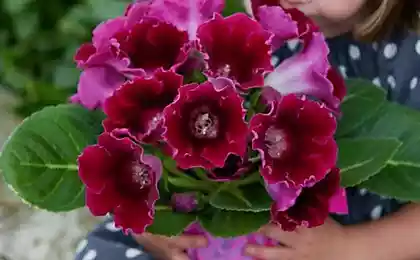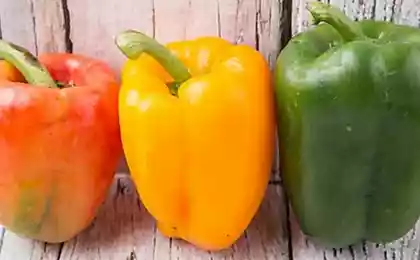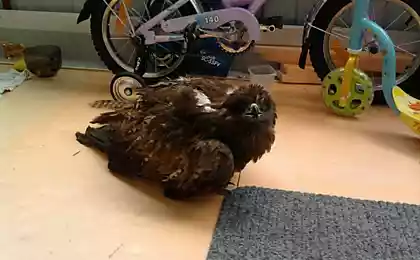763
Ginura: how to care for potted plant
Ginura — blue bird
Plants whose leaves are covered with beautiful hairs, is always particularly striking and throws. After all, like velvet or corduroy leaves create a wonderful play of textures, as if flirting with the textiles in the interior. Among ornamental foliage plants with beautiful edge stands out for its creaminess and originality "blue bird" — a great ginura. This plant with beautiful purple hairs, which effectively emphasizes the beauty of a velvet surface. Unusual colors, unusual shapes and ease of growing ginury turn it into a favorite in recent years.
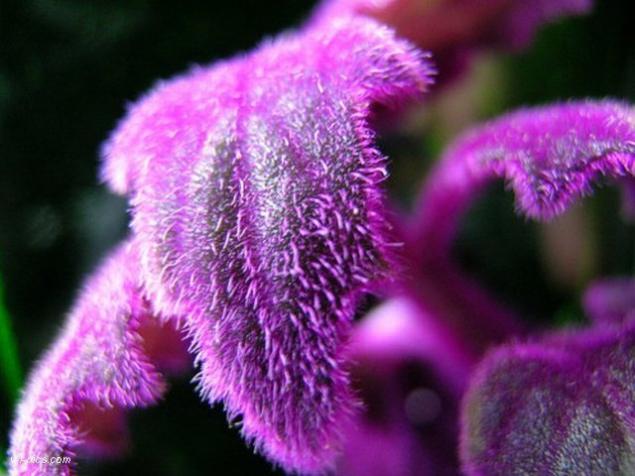
Getting familiar with strange Ginori
Velvet plant (Gynura) – herbaceous shrubs and perennials with long, pleteobrazny zinnatulina shoots and foliage. Twigs ginury square, reach 1 m in length. But in the height of ginura does not exceed 30 cm and grows outwards. The lower leaves always large, up to 20 cm in length, and the upper are much smaller, bow shoots. Leaves with a beautiful scalloped edge often obovate, but different species and varieties, their shape may vary. The foliage gives the whole plant graphic quality and elegance. Velvety leaves ginury amazing combination of softness of the edges and "scratchy" lines. Carved, with teeth, the peaks and "spikes", they give the whole plant the unapproachable, somewhat severe look. However, it is softened by the play of colors, which should be paid special attention. The reverse side of the leaves, a purple color like overflows and extends to the upper side of the sheet plate.
In the culture room grow two types ginury:

This amazingly colorful plant a popular nickname which is "blue bird" as if arguing with species name — ginura orange. In fact, neither orange nor yellow or any other warm colors in ginury will not meet. But it is more famous because of its simplicity, the plant really never ceases to amaze with the variety of color palettes. Basic green and purple combination on the plant in a beautiful and soft transitions. A game of two hues and their saturation is influenced by growing conditions. And if the classic ginor purple leaf edges and petioles are bright foxiewire as gradually blurred to dark green with a bluish tint, then many of Giner at room conditions, the colour changes, becomes dark, or at least more saturated. Watch the plant pleasure. Because the leaves after blooming, more bright, gradually become "gravity" and become more green.
But the flowering of ginury though not the most flashy, but very attractive. Touching the form and the tenderness of the flowers, surprisingly reverent on the background leaves seem charming. Inflorescence-baskets with a bright Golden color and bloom at the tips of branches. But odor slightly "deterred" from ginury inflorescences, and flowering can lead to the violation of the usual bushiness and beauty of the crown. So many growers pluck the flowers, not allowing them to blossom. Flowering starts ginury in anticipation of autumn.

All ginury plants are poisonous. When you work with them you have to be careful not to forget about hand protection.Not gynura to use in the interior of children's rooms.
Ginury plants is definitely attractive. But they have a major drawback: all the "blue birds" prone to degeneration and through several years are beginning to lose appeal, a beautiful purple color. To keep the plant and continue to use it as a luxurious accent in the interior, you need to constantly replace the old bushes, obsolete, new, young copies. But the need of reproduction — the only difficulty in growing ginury. This hardy, undemanding, does not require correction of conditions at the resting stage of the plant, which will surprise even inexperienced gardeners.
Lighting for ginury
Blue bird — light-requiring culture, but not sun. Gynura should be safeguarded from direct sunlight. But do not move it in partial shade, especially shade: bright, indirect lighting for this plant is very important. Because it depends on the color of leaves and the beauty of the purple edges. Especially light ginura climbing, which in ampeli will look beautiful only in well-lit locations.
Choosing a location for ginury, try to focus on the Western and Eastern sills, or similar light locations in the interior. In winter, the plant must be moved to a brighter place to compensate for the loss of daylight and to maintain the usual level of lighting.
Temperature for ginury
This plant is very easy to pick up and suitable temperature of the contents. Ginura does not make a drop of air temperature below 15 degrees even in winter in the resting stage. But not afraid of the heat. She will be comfortable in a familiar indoor environment, especially if the temperature will not go beyond the range of 20-24 degrees Celsius.
Winter temperatures drop to 15 degrees (but not below 10 degrees) can extend the life ginury. But still, the bushes will have to change to a new one, though not with frequency of 2-3 years. But one extra season, do not hassle with complicated correction care and moving plants. Therefore, the strategy of the winter lower temperatures rarely used.
In order to achieve high decorative plant, it is necessary to provide fresh air. What to do is not so simple, given the dislike ginury to the drafts. This plant needs frequent ventilation, protection of crops from the active air flow.
Watering and humidity
Glaze ginury require particular care. Despite its durability, this plant is very afraid of getting wet. And moisture on leaves and shoots may become a detrimental factor to lead to serious health problems of plants. So pour gynura need very carefully, on the edge of the pot or alternative methods.
The mode of procedures to pick up quite easily. Throughout the stage of active development, from March until the end of October, ginura needs a stable easy humidity of the substrate. Best to plant to prevent a complete drying earthen coma, and waterlogged. The following procedure is carried out only after it dries out the top few centimeters of the substrate. Ginury more suitable for frequent and scant watering than intense but rare.
Reduce watering in the winter — the only measure of the care that needs to be adjusted for a comfortable passing a state of dormancy. For ginury glaze not only reduce but also alter the degree of humidity of the substrate for a light hydration. Between treatments from November to February the soil in the pot allow to dry out and in the middle layer.
Pay attention to the water quality. For ginury you can only use water at room temperature, soft and settled.
Fortunately, the humidity of the air ginura not demanding. It does not tolerate wet leaves and spraying dislikes. And other measures to increase air humidity are not needed, because the dryness does not affect the attractiveness of the edge.
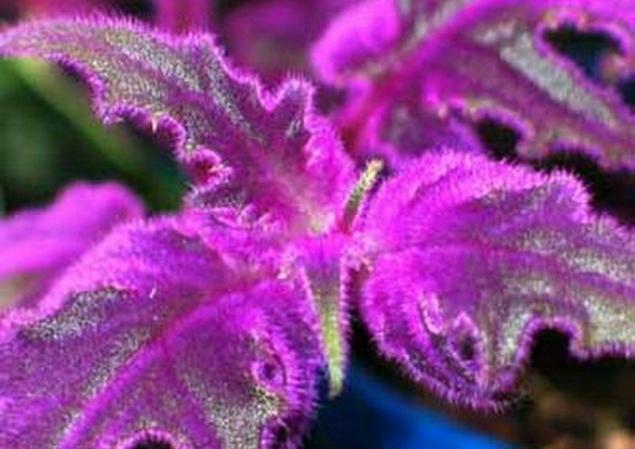
Feeding for ginury
This plant needs a sufficiently modest dressing. Like all foliage plants, ginura more needs in nitrogen than potassium and phosphorus, but the excess of nitrogen in the soil can cause greening of the leaves, too rapid growth and a violation of the attractiveness of curtains. A dressing ginura needs from March to October. Fertilizer is better to use from among the mixtures of the generic type, making them 2-3 times a month.
In the winter time feeding for ginury better not do it at all. A pause in the fertilizer make for the period from November until the end of February.
Garter bushes and pruning ginury
Ginura orange especially if it is growing in a basket, and in potted form, in need of tying. If roots will lie down, will not be attached to the support as growth, ginura will slow their development and may stop altogether. Garter is a kind of "boost", allowing the bushes to look attractive all year.
But not only about tying, care should be taken. If gynura shape, it will not create a dense and beautiful crown. Periodically pinch the tops of the shoots to stimulate branching and the active formation of side-shoots.

Transplant "the blue bird"
Ginura requires fairly frequent transplanting, but it is better not to spend at a certain frequency, and according to the needs of the plants. If the soil ball is completely filled with roots – feel free to change the capacity. If the substrate is enough for growth and development, then your genure transplant will be required. For this plant is suitable only for one-time transplantation — early spring. Most often gynura transplanted 1 every 2 years, throwing out old bushes and replacing them with new ones. When transplanting ginury sure to lay on the bottom of the tanks a layer of drainage, and the level of penetration remains the same.
Substrate: easy, from the number of universal samlemesse or potting mix of equal parts humus, turf and leaf soil with a small addition of sand.
Pests and diseases
Ginura orange as ginura climbing are proof enough potted crops. If you do not allow waterlogged and wet leaves, diseases of the Bluebird is not terrible. But the pests occur much more often. Ginorm annoying whiteflies, spider mites and molochniki. To combat insects by washing is impossible, it is better to use insecticides. But don't forget about the correction treatment which will act as a prevention measure.
Common problems in growing ginury:
Fortunately for all gardeners, ginura is one of the easiest in breeding cultures. In this parameter it can compete except that the Chlorophytum.
Easier and more productive just to ginury propagated by cuttings. They can be cut from spring to mid-autumn, using apical cuttings in any quantity. Rooting is not a task just simple and basic. Because the shoots ginury very quickly produce roots in plain water. Actually, rooting is only 1 week. Thus no effort and no cost time and energy, you can always get new plants. That is why gynura so just replace at the first sign of degeneration of the bushes.published
P. S. And remember, just changing your mind — together we change the world! ©
Source: vk.com/public47900340?w=wall-47900340_283465
Plants whose leaves are covered with beautiful hairs, is always particularly striking and throws. After all, like velvet or corduroy leaves create a wonderful play of textures, as if flirting with the textiles in the interior. Among ornamental foliage plants with beautiful edge stands out for its creaminess and originality "blue bird" — a great ginura. This plant with beautiful purple hairs, which effectively emphasizes the beauty of a velvet surface. Unusual colors, unusual shapes and ease of growing ginury turn it into a favorite in recent years.

Getting familiar with strange Ginori
Velvet plant (Gynura) – herbaceous shrubs and perennials with long, pleteobrazny zinnatulina shoots and foliage. Twigs ginury square, reach 1 m in length. But in the height of ginura does not exceed 30 cm and grows outwards. The lower leaves always large, up to 20 cm in length, and the upper are much smaller, bow shoots. Leaves with a beautiful scalloped edge often obovate, but different species and varieties, their shape may vary. The foliage gives the whole plant graphic quality and elegance. Velvety leaves ginury amazing combination of softness of the edges and "scratchy" lines. Carved, with teeth, the peaks and "spikes", they give the whole plant the unapproachable, somewhat severe look. However, it is softened by the play of colors, which should be paid special attention. The reverse side of the leaves, a purple color like overflows and extends to the upper side of the sheet plate.
In the culture room grow two types ginury:
- colorful perennial ginura orange (gynura aurantiaca), forming a fluffy mass of vivid leaves, suitable for pot and basket culture;
- more suited to basket culture rare gynura lassuy (gynura scandens), which looks great in pots due to shorter branches generates original and thick bushes. Her leaves are smaller, softer, ovate.

This amazingly colorful plant a popular nickname which is "blue bird" as if arguing with species name — ginura orange. In fact, neither orange nor yellow or any other warm colors in ginury will not meet. But it is more famous because of its simplicity, the plant really never ceases to amaze with the variety of color palettes. Basic green and purple combination on the plant in a beautiful and soft transitions. A game of two hues and their saturation is influenced by growing conditions. And if the classic ginor purple leaf edges and petioles are bright foxiewire as gradually blurred to dark green with a bluish tint, then many of Giner at room conditions, the colour changes, becomes dark, or at least more saturated. Watch the plant pleasure. Because the leaves after blooming, more bright, gradually become "gravity" and become more green.
But the flowering of ginury though not the most flashy, but very attractive. Touching the form and the tenderness of the flowers, surprisingly reverent on the background leaves seem charming. Inflorescence-baskets with a bright Golden color and bloom at the tips of branches. But odor slightly "deterred" from ginury inflorescences, and flowering can lead to the violation of the usual bushiness and beauty of the crown. So many growers pluck the flowers, not allowing them to blossom. Flowering starts ginury in anticipation of autumn.

All ginury plants are poisonous. When you work with them you have to be careful not to forget about hand protection.Not gynura to use in the interior of children's rooms.
Ginury plants is definitely attractive. But they have a major drawback: all the "blue birds" prone to degeneration and through several years are beginning to lose appeal, a beautiful purple color. To keep the plant and continue to use it as a luxurious accent in the interior, you need to constantly replace the old bushes, obsolete, new, young copies. But the need of reproduction — the only difficulty in growing ginury. This hardy, undemanding, does not require correction of conditions at the resting stage of the plant, which will surprise even inexperienced gardeners.
Lighting for ginury
Blue bird — light-requiring culture, but not sun. Gynura should be safeguarded from direct sunlight. But do not move it in partial shade, especially shade: bright, indirect lighting for this plant is very important. Because it depends on the color of leaves and the beauty of the purple edges. Especially light ginura climbing, which in ampeli will look beautiful only in well-lit locations.
Choosing a location for ginury, try to focus on the Western and Eastern sills, or similar light locations in the interior. In winter, the plant must be moved to a brighter place to compensate for the loss of daylight and to maintain the usual level of lighting.
Temperature for ginury
This plant is very easy to pick up and suitable temperature of the contents. Ginura does not make a drop of air temperature below 15 degrees even in winter in the resting stage. But not afraid of the heat. She will be comfortable in a familiar indoor environment, especially if the temperature will not go beyond the range of 20-24 degrees Celsius.
Winter temperatures drop to 15 degrees (but not below 10 degrees) can extend the life ginury. But still, the bushes will have to change to a new one, though not with frequency of 2-3 years. But one extra season, do not hassle with complicated correction care and moving plants. Therefore, the strategy of the winter lower temperatures rarely used.
In order to achieve high decorative plant, it is necessary to provide fresh air. What to do is not so simple, given the dislike ginury to the drafts. This plant needs frequent ventilation, protection of crops from the active air flow.
Watering and humidity
Glaze ginury require particular care. Despite its durability, this plant is very afraid of getting wet. And moisture on leaves and shoots may become a detrimental factor to lead to serious health problems of plants. So pour gynura need very carefully, on the edge of the pot or alternative methods.
The mode of procedures to pick up quite easily. Throughout the stage of active development, from March until the end of October, ginura needs a stable easy humidity of the substrate. Best to plant to prevent a complete drying earthen coma, and waterlogged. The following procedure is carried out only after it dries out the top few centimeters of the substrate. Ginury more suitable for frequent and scant watering than intense but rare.
Reduce watering in the winter — the only measure of the care that needs to be adjusted for a comfortable passing a state of dormancy. For ginury glaze not only reduce but also alter the degree of humidity of the substrate for a light hydration. Between treatments from November to February the soil in the pot allow to dry out and in the middle layer.
Pay attention to the water quality. For ginury you can only use water at room temperature, soft and settled.
Fortunately, the humidity of the air ginura not demanding. It does not tolerate wet leaves and spraying dislikes. And other measures to increase air humidity are not needed, because the dryness does not affect the attractiveness of the edge.

Feeding for ginury
This plant needs a sufficiently modest dressing. Like all foliage plants, ginura more needs in nitrogen than potassium and phosphorus, but the excess of nitrogen in the soil can cause greening of the leaves, too rapid growth and a violation of the attractiveness of curtains. A dressing ginura needs from March to October. Fertilizer is better to use from among the mixtures of the generic type, making them 2-3 times a month.
In the winter time feeding for ginury better not do it at all. A pause in the fertilizer make for the period from November until the end of February.
Garter bushes and pruning ginury
Ginura orange especially if it is growing in a basket, and in potted form, in need of tying. If roots will lie down, will not be attached to the support as growth, ginura will slow their development and may stop altogether. Garter is a kind of "boost", allowing the bushes to look attractive all year.
But not only about tying, care should be taken. If gynura shape, it will not create a dense and beautiful crown. Periodically pinch the tops of the shoots to stimulate branching and the active formation of side-shoots.

Transplant "the blue bird"
Ginura requires fairly frequent transplanting, but it is better not to spend at a certain frequency, and according to the needs of the plants. If the soil ball is completely filled with roots – feel free to change the capacity. If the substrate is enough for growth and development, then your genure transplant will be required. For this plant is suitable only for one-time transplantation — early spring. Most often gynura transplanted 1 every 2 years, throwing out old bushes and replacing them with new ones. When transplanting ginury sure to lay on the bottom of the tanks a layer of drainage, and the level of penetration remains the same.
Substrate: easy, from the number of universal samlemesse or potting mix of equal parts humus, turf and leaf soil with a small addition of sand.
Pests and diseases
Ginura orange as ginura climbing are proof enough potted crops. If you do not allow waterlogged and wet leaves, diseases of the Bluebird is not terrible. But the pests occur much more often. Ginorm annoying whiteflies, spider mites and molochniki. To combat insects by washing is impossible, it is better to use insecticides. But don't forget about the correction treatment which will act as a prevention measure.
Common problems in growing ginury:
- the loss of the purple color or blanching of leaves to low light;
- elongation of shoots in the penumbral shadow;
- leaf drop in the drying of the substrate and too rare watering;
- the degeneration of leaves when there is insufficient feeding and poor lighting.
Fortunately for all gardeners, ginura is one of the easiest in breeding cultures. In this parameter it can compete except that the Chlorophytum.
Easier and more productive just to ginury propagated by cuttings. They can be cut from spring to mid-autumn, using apical cuttings in any quantity. Rooting is not a task just simple and basic. Because the shoots ginury very quickly produce roots in plain water. Actually, rooting is only 1 week. Thus no effort and no cost time and energy, you can always get new plants. That is why gynura so just replace at the first sign of degeneration of the bushes.published
P. S. And remember, just changing your mind — together we change the world! ©
Source: vk.com/public47900340?w=wall-47900340_283465
Generator Adams-VEGA: the most efficient magnetic motor
The first Volvo electric car will be two years







